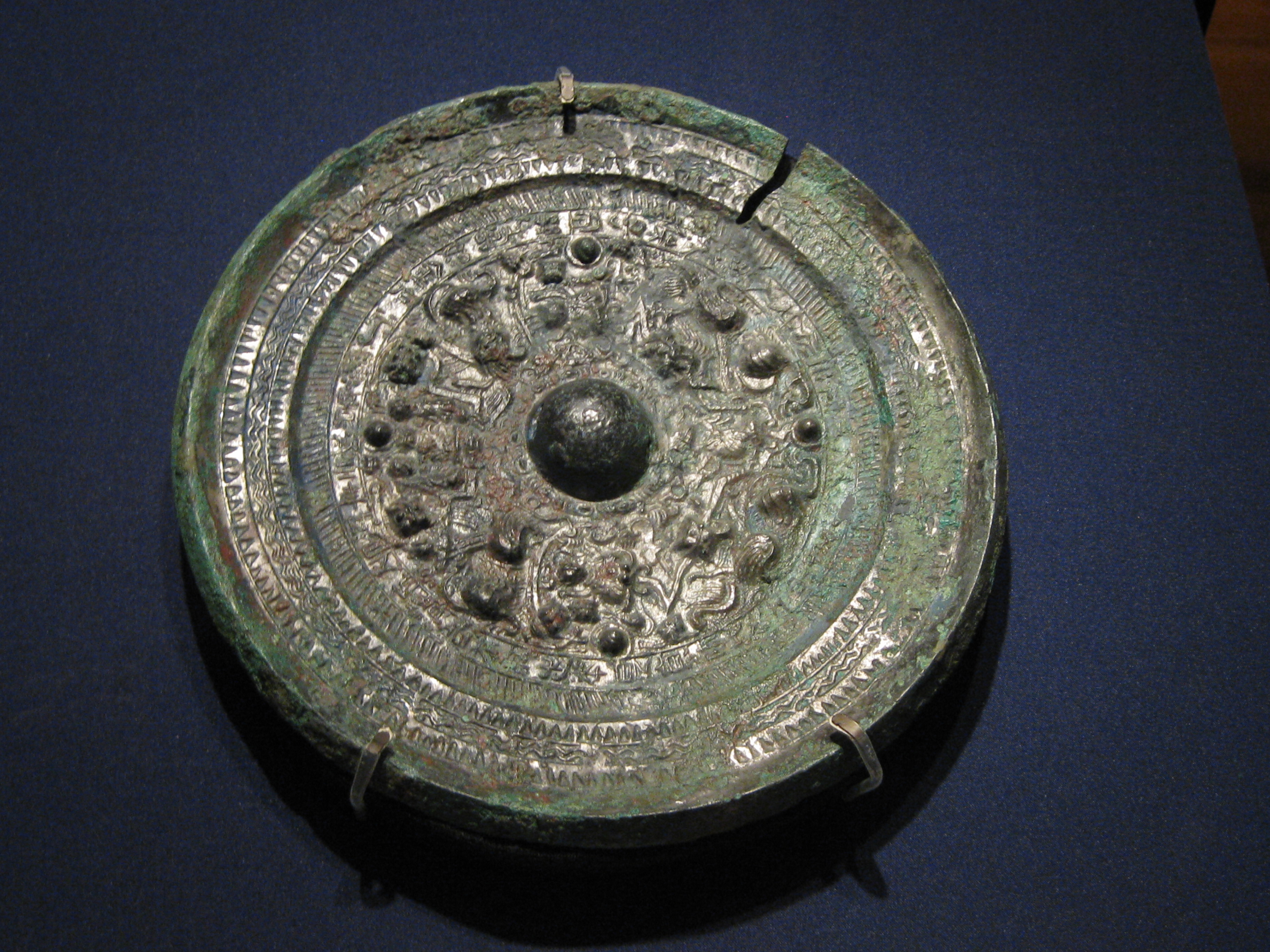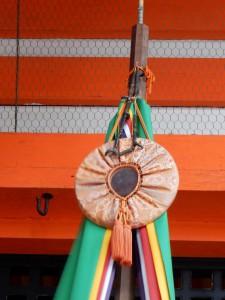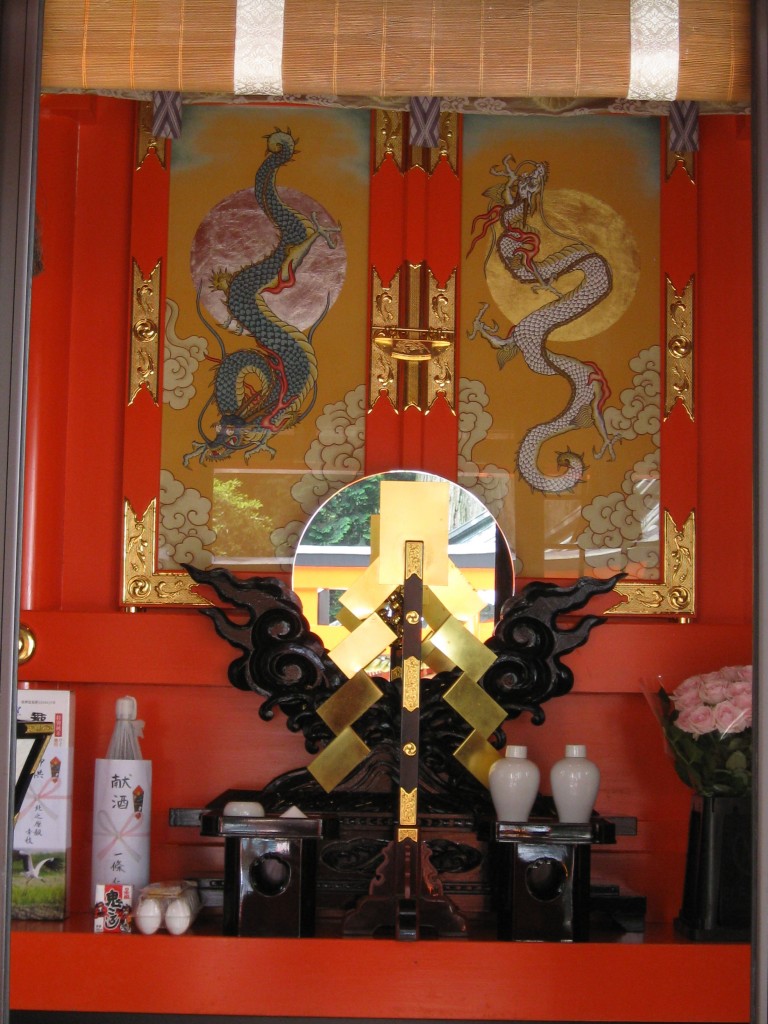
The bronze mirror of antiquity was a precious and sacred object. Here the carved back is displayed, the other side was carefully polished so as to reflect sunlight.
The circular mirror of Shinto is a potent symbol. One often sees it when visiting shrines, for it stands on the altar as representative of the kami, and in particular of Amaterasu the sun goddess. It can play a more vital role too, as the ‘spirit-body’ (goshintai) into which the kami descends. The idea is that within the reflecting surface is housed something beyond normal understanding, for the illusionary nature of a reflected image is both real and unreal at the same time. The mirror is thus an interface between the physical and spiritual realms. What could be more appropriate? Through the looking-glass lies a Wonderland, yet the Wonderland is right here around us.
In Japanese mythology the original mirror belonged to Amaterasu, the Sun Goddess who dwells in Heaven. When her grandson, Ninigi, descended to earth, she gave him a precious bronze mirror, circular in shape ‘Take this and revere it as if it were myself,’ she told him. It was as if her radiance had seared her spirit into the very metal.

The misakaki at Shinto shrines has a covered bronze mirror
According to mythology, her grandson Ninigi passed the mirror down to his great grandson, Emperor Jimmu, first of the earthly emperors. It was the supposed start of the imperial succession which continues to this very day, and the present emperor is held to be the 125th in line. Tradition states that the mirror was originally kept in the palace of the king of Yamato, before being deposited at Ise Jingu in the early centuries of the Common Era. Since that time it has been unseen by human eye, hidden behind wooden doors. The millions of pilgrims who visit each year pray towards this unseen presence.
As the ancestral shrine of the imperial family, Ise is the country’s premier shrine as it houses the ‘spirit-body’ of the sun goddess herself. Here then is the country’s holiest of holies, its symbolic soul. In this sense, Japan truly is a mirror. The idea of a circular mirror carrying such significance might seem odd, but it’s worth noting that ancient Chinese believed the human soul to be a shining disc, a connotation that carried over to the bronze mirror.
For early humans the bronze mirror was a powerful spiritual tool, acting as a kind of ray gun which would emit reflected light to dispel the forces of darkness. Shamans hung them on their chest to ward off evil, similarly they were fixed to the front of ships to ensure victory at sea. Given its power and precious properties, it became a highly valued symbol of authority, and beautifully wrought mirrors were presented as the highest form of gifts to kings and deities. Together with the sword and magatama beads, a bronze mirror is one of the three sacred regalia of the Japanese emperor.
In modern shrines the mirror that sits on the altar is intended to invoke feelings of purity, gratitude, and awe. Yet in some shrines the mirror is fixed at such an angle that when worshippers pray, they find they are looking at their own reflection. How suggestive! People praying to the divine within themselves. As in Hinduism, it’s not a case of God be with you, but God is in you! As descendants of the kami, humans are also part of the divine order and live in a sacred world. There is no future heaven, no Garden of Eden from which we have been ejected, for it’s right here, right now. Look in the mirror and paradise is there. It’s this life-affirming assertion which makes Shinto so appealing.
***************
The above is an extract from a work in progress, tentatively titled Within the Mirror
***************

Mirror with reflection of a ‘gohei’ into which the kami descends

Domo aregato for your well researched insights into the Japanese culture, tradition, customs and everyday life. Especially the article about first sharing rice wine with a carp and then returning the fish-kami into the river is a best fitting example for Nippon’s culture, an amusing account of shinto religion to share even with my grandchildren. Great, good news to smile about: let the silent fish god/dess have some fun too and then release it into nature back again. ‘ Fishes are said to avoid all to clear water.’ as Haga-kure tells and here is why..😉